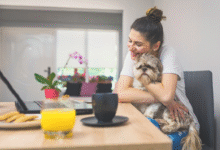
Pet Body Language: What Your Pet Is Trying to Tell You
Pets communicate with us every day, but understanding their body language can sometimes feel like decoding a mysterious language. In this guide, we delve into the nuances of pet behavior, offering insights and tips to help you decipher what your furry friend is trying to tell you. From wagging tails to subtle ear movements, every gesture conveys a message. Let’s explore the fascinating world of pet body language together.
Read More: Understanding Pet Communication: Interpreting Body Language and Vocalizations
Decoding Tail Wagging: What Does It Mean?

Understanding your pet’s tail wagging is essential for interpreting their mood and intentions. While a vigorous wag may signal excitement or happiness, a slow wag could indicate uncertainty or caution. Pay attention to the speed, height, and direction of the wag to gain deeper insights into your pet’s emotions.
Tail Wagging Tips
- Fast and high wags typically indicate happiness.
- A low, slow wag might suggest anxiety or apprehension.
Tail wagging is one of the most recognizable forms of communication in dogs. However, it’s essential to understand that not all wagging is a sign of happiness. The context and accompanying body language provide crucial clues to deciphering its meaning.
Reading Facial Expressions: The Eyes, Ears, and Mouth
Pets convey a wealth of information through their facial expressions. By observing their eyes, ears, and mouth, you can gain valuable clues about their state of mind. Dilated pupils, flattened ears, or bared teeth may all signal varying levels of stress or discomfort.
Facial Expression Insights
- Relaxed eyes and softly perked ears indicate contentment.
- Narrowed eyes or pinned-back ears may signal fear or aggression.
Eyes are often referred to as the window to the soul, and this holds true for pets as well. They can communicate a range of emotions, from joy and affection to fear and anxiety. By paying close attention to your pet’s facial expressions, you can gain a deeper understanding of their inner world.
Posture and Body Positioning: What Your Pet’s Stance Reveals

A pet’s posture can speak volumes about their emotions and intentions. Whether they’re standing tall with an arched back or crouching low to the ground, their body language provides valuable insights into their mood. Understanding these subtle cues can help you respond appropriately to your pet’s needs.
Posture Interpretations
- An upright stance with a relaxed body suggests confidence and comfort.
- Hunching or cowering may indicate fear or submission.
Body language is a universal form of communication among animals, including humans. Pets use their posture to express a wide range of emotions, from happiness and relaxation to fear and anxiety. By observing your pet’s body positioning, you can gain valuable insights into their emotional state and well-being.
Vocalizations: Interpreting Barks, Meows, and Whines
Just like humans, pets use vocalizations to communicate a range of emotions and desires. Whether it’s a cheerful bark, a plaintive meow, or a low growl, each sound carries its own meaning. By listening closely to your pet’s vocal cues, you can better understand their needs and preferences.
Vocalization Insights
- Sharp, high-pitched barks often indicate excitement or alarm.
- Low, rumbling growls may signal aggression or discomfort.
Vocalizations play a significant role in pet communication, allowing them to express a wide range of emotions and needs. By paying attention to the pitch, tone, and intensity of your pet’s vocalizations, you can gain valuable insights into their state of mind and respond accordingly.
Understanding Pet Body Language: What Your Pet Is Trying to Tell You

Pets rely on body language to express their feelings and desires, and as pet owners, it’s our responsibility to learn their unique communication cues. By paying attention to tail wagging, facial expressions, posture, and vocalizations, we can deepen our bond with our furry companions and ensure their well-being and happiness.
Read More: Pet-Friendly Technology: Gadgets for Pet Parents
FAQs
- What does it mean when my cat purrs? When a cat purrs, it typically signifies contentment and relaxation. However, cats may also purr when they’re anxious or in pain.
- Why does my dog bark at strangers? Dogs bark at strangers as a form of alerting their owners to potential threats or expressing fear or territorial behavior.
- How can I tell if my pet is feeling anxious? Signs of anxiety in pets include pacing, panting, trembling, excessive grooming, and avoidance behavior.
- What does it mean when my rabbit thumps its hind legs? Rabbit thumping is often a sign of distress or agitation. It can indicate fear, anger, or a desire to communicate a warning.
- Why does my bird puff up its feathers? Birds puff up their feathers as a way to conserve heat, regulate body temperature, or display aggression or excitement.
- Is it normal for my pet to hide when they’re scared? Yes, hiding is a common coping mechanism for pets when they feel frightened or stressed. It’s essential to provide them with a safe space to retreat to during these times.
The Final Words
Unlock the secrets of pet body language and communication and strengthen your bond with your furry companion by learning to interpret their body language. By observing their tail wagging, facial expressions, posture, and vocalizations, you can gain valuable insights into their emotions and needs. Remember to be patient and attentive, and always respond to your pet with love and understanding.







